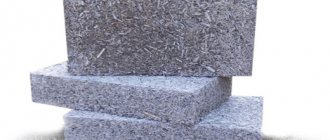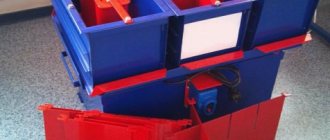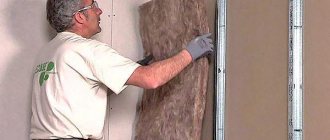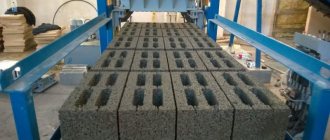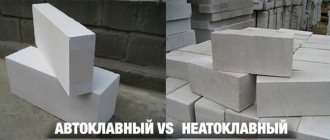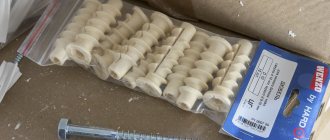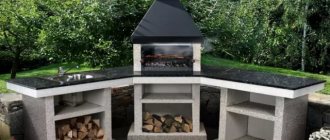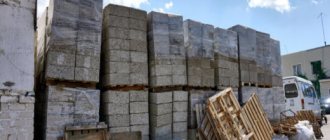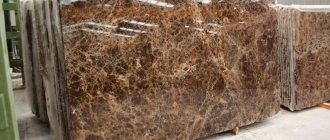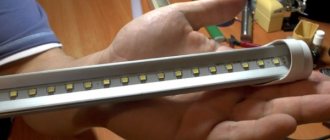Various types of lightweight concrete have recently become popular in the construction industry.
One of them is wood concrete or wood concrete blocks, which are made from Portland cement, minerals, wood chips, aggregate, chemical additives and water.
Large companies around the world are engaged in the production of wood concrete blocks, but you can make them yourself if you take the trouble to manufacture special equipment. A machine for the production of wood concrete blocks includes many parts and mechanisms. Let's take a closer look at them.
Production line
When mass producing building raw materials from wood concrete, it is necessary to carefully prepare the wood materials, as well as study a special method for forming blocks from the mixture. Only by using the right raw materials, special equipment and technology can you obtain high-quality blocks suitable for construction according to all standards. To set up a production line you will need :
vibropress;- self-sealing form;
- lift-and-turn bunker;
- bunker control winch;
- mixer;
- winch for lifting dispensers;
- chip dispenser;
- cement dispenser;
- containers for making wood and mortar;
- mixture distributor;
- Dryer;
- pallets;
- trolley for transporting pallets.
Important ! To set up the production line, it is necessary to use all of the listed equipment. Thanks to such capacities, it is possible to produce up to 350 wood concrete blocks per day.
It is recommended to consider in more detail individual technical units for the manufacture of wood concrete blocks, as well as the requirements for them.
Chip machines
Wood concrete chips are made from coniferous wood . This material makes up 75% of the filling of the wood concrete block. The particle size is 25x12 mm: to obtain such dimensions, you will have to use crushing equipment for wood chips. It goes like this:
- chippers;
- wood chippers;
- crushers.
Tank chippers are needed to grind the logs into pieces of a given dispersion. When the conveyor delivers the log to the receiving window, it is pulled in, secured and directed to the cutting disc.
In wood chippers, wood is loaded into a special compartment, from where it is fed to the cutting tool and reduced to the smallest particles.
The crusher works on the principle of crushing raw materials using sharp knives. It should rotate 360 degrees, and the blades of the knives should be made of high-quality steel that is resistant to wear. A large number of cutting elements guarantees a long service life of the equipment. The thickness of the case must be at least 2 cm . A popular device of this type is produced by the companies Krafter, Untha, Walter.
There are also requirements for chip cutters: they must be reliable. And all the nodes are removable. Light cleaning will only make the job easier, and high-quality knives will make the wood chipper durable. Production is carried out by Russian companies, as well as a company from China, Boxer. Chips are produced by Junkkari and Ahlstrom companies.
Mixers for wood concrete
Since wood concrete is produced on the basis of a liquid mixture, and its composition includes various components, a standard concrete mixer will not work here.
To mix the mass, special mixing stations are used . For example, the Rifey company from the Chelyabinsk region produces such devices.
Model SG-1000 meets all requirements and has the following characteristics:
- loading up to 1000 liters;
- horizontal rotors;
- power 7.5 kW;
- volume for oil in the gearbox – 4 liters;
- engine speed – 1500 rpm.
Mixers must be equipped with a durable thick body, rotors for mixing, as well as an unloading hatch and a powerful electric motor with a gearbox. Modern mixing stations have a control panel , which makes operation convenient.
Vibropress
For both private and large-scale production of wood concrete blocks, a press is required. The essence of his work is simple:
- The wood is loaded into the matrix.
- The press is turned on and the first stage of mass compaction occurs.
- The vibration press is turned off, and the remaining mass is removed to the upper level of the matrix.
- Then the vibrator is turned on again, the lever is lowered and compaction is carried out again.
Note ! In modern equipment, brick-making presses immediately have the function of molding wood concrete blocks. After repeated pressing, the equipment distributes the mass into molds, and then lays them out on pallets. After the tray has been removed, the next batch of mixture can be loaded.
Large factories in Russia and foreign countries are engaged in the production of such equipment . For example, the BlockPress company from Ufa manufactures equipment for a line of production of wood concrete blocks. The VPRS Arbolit brick making machine is equipped with 2 matrices at once. It weighs 165 kg and allows you to get blocks measuring 300x200x500 mm. In 8 hours, up to 300 units of block material are formed.
Drying devices
Wood concrete blocks can be dried naturally, but this greatly increases the time it takes to obtain the finished material for construction.
To make the process go faster, special drying chambers are used. The better the camera works, the better the characteristics of the blocks.
The camera visually looks like a large drum with a diameter of 2.2 meters . It consists of 2 parts: internal and external.
The outer part is equipped with perforation - warm air flows through it to blow the wood concrete blocks.
The outer drum makes several tens of revolutions per minute to dry the blocks. In this way, up to 100 such blocks can be dried in 8 hours . Dryers are available with power from 4 to 11 kW: the higher the power, the faster the blocks dry.
Forms
The forms are made of steel and are equipped with two side handles . There is padding inside, as well as two removable covers - top and bottom. It is better to choose those shapes that are made by laser cutting. This method allows you to obtain smoother surfaces.
The forms are filled using pressing, since it is very important to obtain wood concrete blocks that are the same in weight and density.
When the forms are filled, they are covered with special plates and fixed on all sides. Then the mold with the material is removed from the vibrating table and sent to the drying chamber. The production of molds is carried out by factories that manufacture equipment for the production of wood concrete.
Necessary equipment for production
To make arbolite blocks at home, you will need three types of equipment: a unit for grinding wood chips, a concrete mixer or concrete mixer, and a machine for forming arbolite blocks. However, the primary material - wood chips - can be purchased from third-party manufacturers , in which case the technological process will become much simpler.
There is a fairly wide range of equipment on the market for the production of wood blocks - from small-sized units specifically for small-scale production to full-fledged production lines containing several types of equipment.
Chip cutters
A device for making wood chips is called a wood chipper. It is a drum or disk type chipper that can grind chopped wood and bushes left after cutting down the forest into chips.
The configuration of almost all units is identical; they consist of a receiving hopper, an electric motor, breaking knives, a rotor and the body of the machine.
Disc units are distinguished by their relatively small-sized parameters and lower cost, while drum chippers have increased productivity, which makes them popular in the production of large series of products.
Disc units make it possible to process trees up to three meters in size. The advantages of this type of units include the smallest number of large components at the output - more than 90% of the wood chips have the required configuration and dimensions, large particles are re-processed. This is an ideal choice of equipment for establishing small-scale production.
Machine
Such equipment can be confidently called semi-professional. As a rule, it is purchased for the purpose of manufacturing arboblocks in private construction to order or for sale. It is easy to operate and does not require high professionalism, primarily associated with ensuring safety regulations.
Industrial units can be symbolically divided into three key groups:
- manual machines;
- units with a vibration press and bunker feeding;
- complex combined units connecting the receiver with the initial weight, a vibration press and a static molder, which maintains the density of the wood concrete solution until the final hardening of the wood block into the finished product.
Concrete mixer
An ordinary mixer with flat blades is not suitable for mixing wood concrete mortar. Everything is explained by the fact that the mixture is half dry, it does not spread, but is able to rest in a slide; the blade simply drives it from one corner of the tank to another corner, and not all the chips are covered with cement paste.
The SAB-400 concrete mixer has special “ploughs” in its structure - knives that cut the mixture, and it is effectively (and most importantly, fast) mixing it. Speed is important, since the cement should not have time to set until it has covered all the crushed material.
Concrete mixer
In the process of manufacturing arboblocks, as a rule, pulse mixers are used, and from time to time - construction mixers. On large lines, where the production of building materials is carried out in large quantities, equipment with a continuous nature of operation is installed. In order to meet the needs of not very large productions, in most cases ordinary concrete mixers are used, which have the following structural characteristics:
- are large containers with side loading of ingredients and bottom unloading of the prepared solution;
- the mixer is equipped with an electric motor with a gearbox with a maximum power of 6 kW;
- Special blades are used to mix the wood concrete ingredients.
The volume of the mixer is calculated based on the daily need for materials to establish an effective technological process.
Vibropress
The area of the vibrating table (vibropress) also depends on the size of the molding dispenser. The vibropressing machine is a metal table proportional to the size of the dispenser, which is equipped with springs and is associated with a frame (the main heavy table). A three-phase electric motor up to 1.5 kW is installed on the frame, on the axis of which there is an eccentric (a load whose center of gravity is shifted). When the latter is connected, regular vibration processes occur in the upper part of the table. These actions are required for optimal shrinkage in the forms of the composition of wood concrete blocks and the elimination of mechanical and external defects of the blocks after removal of the form.
Forms
The matrix (form, press panels) for the production of blocks is intended to give the product specific dimensions and configuration. It depends on it how accurate the shape of the block will be.
Read also: Wire precision GOST 3282 74
The matrix is a form with a rectangular contour that is empty inside, in which the solution is filled. This form includes a removable lid and bottom. The shape has specialized handles along the edges. Inside, it is equipped with a specific coating designed to simplify the removal of the formed block.
Basically, smooth artificial material is used for the internal covering; it can be polyethylene film, linoleum or other similar materials.
Drying chambers
Finished arboblocks, which are pressed properly, together with the matrices are sent to a specialized room. In it, the level of air humidity is strictly controlled, which makes it possible to create optimal conditions for drying the material.
The blocks must be laid out on pallets and freed from the matrices. Which optimizes the access of air masses to the material, this has a positive effect on its properties.
The adhesion of the solution, as a rule, occurs after two days. The design capacity of the building material is obtained only after 18-28 days . All this time, the wood concrete must remain in an environment of the required humidity and stable temperature.
In home production, as a rule, a pressed batch of wood blocks is laid out in a dark place, covered with a polyethylene film and a protective fabric awning. After 2-3 days, the blocks are moved indoors and laid out in one layer on the stone floor. After 7 days, the blocks can be placed in packs.
Self-created
To set up a production line for wood concrete blocks, it is not necessary to purchase expensive equipment, but in some cases it cannot be replaced. You can make an alternative with your own hands in the case of a chip cutter, mixer and compactor.
How to make a wood chipper yourself?
To make a wood chip cutter with your own hands, you will need a metal sheet up to 20 mm thick . A circle with a diameter of 300-350 mm is cut out of it. A hole is made inside and a key is inserted. Symmetrical slits are made on the outer perimeter of the circle. For knives I use springs from a car, they are cut into strips of metal, and then sharpened and screwed to the base.
It is also necessary to make a hammer mechanism. For this purpose, metal strips with a thickness of 5 mm are used. They are located on the rotor. A sieve is also prepared: it is made from a round metal container, where a ring is cut off, and then holes are made with a drill. In order to conveniently push chips out of the machine, it is necessary to make crossbars on the back of the disk. As the disc rotates, they will also rotate, thereby pushing the chips out.
Mixer
You can build a concrete mixer for wood concrete with your own hands, thereby not having to spend money on equipment from the factory. To do this you will need a 200 liter barrel, wheels, angles, channels and pipes . You also need fittings, a gearbox, and an electrical wire - it is better to make an electric concrete mixer than a mechanical one.
If you take an old-style washing machine, you can use the electric motor from it. You also need bearings and a large amount of fasteners: screws, bolts and nuts.
Note ! You need to prepare tools: a hacksaw, welding machine, grinder, drill, pliers and a set of keys.
First, a welded frame is made, then containers for mixing the solution are assembled. Next, install the electric drive and gearbox, and connect the wiring to them. At the final stage, it is necessary to check all equipment for its serviceability and safety.
Sealant
The seal design consists of several elements:
- table top;
- vibration device;
- table;
- compaction device.
First, the table is made: it consists of legs that are welded to the frame. The frame is made rectangular, its dimensions are 50x70 cm. The length of the legs is adjusted to suit your preferences. The tabletop must have cross braces, as it will be subject to serious loads. It must match the frame format.
The compactor requires a powerful motor; it is recommended to take a product of type VI99/E - it can adjust the oscillation frequency.
Equipment price: what does it depend on?
The cost of equipment for the production of wood concrete blocks depends on the manufacturing plant, the region of sale, as well as on the materials used in the machines. Several examples of prices in Russia for equipment :
- mixer – 159,000 rubles;
- brick press – from 46,000 to 59,000 rubles;
- drying equipment – 750,000 rubles;
- forms - from 1800 to 2400 rubles;
- wood chippers – 99,900 rubles.
The cost of equipment also depends on the modification . For example, a brick press with 1 die will be cheaper than equipment with 2-3 dies. A mold for wood concrete with 2 cells will cost less than one with 3-4 cells.
What is wood concrete
Wood concrete or wood concrete is a building material consisting of organic fillers (mainly wood) in a proportion of up to 90%, cement and chemical additives. This is a relatively young material - it was invented in the 1930s in Holland, and it came to Russia in the 60s.
Wood concrete can be considered a material that has been undeservedly ignored. Despite its high quality characteristics and minor shortcomings (some of which are easy to compensate for), it was not widely used in Soviet and Russian mass construction. It was abandoned in favor of large concrete blocks, which speed up the process of building houses. For example, in Europe, Canada and the USA, there are much more buildings made of wood concrete (where it is called “woodstone”).
Benefits of wood concrete
The production of wood concrete blocks is a promising line of business in the field of building materials and here’s why:
- The strength of wood concrete is comparable to that of ordinary concrete, and the strength of brick is 2-3 times greater.
- At the same time, the material is resistant to bending and is able to restore its shape after unwanted deformation.
- Despite the presence of wood residues in the composition, it is fireproof.
- Good sound insulation performance.
- Excellent heat retention. Wood concrete buildings were erected even in Antarctica, and the thickness of their walls was only 30 centimeters.
- An environmentally friendly material, it is also based on waste from the wood processing industry.
- Long service life. Arbolite buildings do not mold, do not rot and are resistant to chemicals.
- The material is lighter than brick and concrete, making it easier to build with.
- The shape of arbolite blocks can be adjusted using a regular saw.
Disadvantages of wood concrete
This material also has weaknesses, and the main one is low moisture resistance. They try not to use wood concrete in rooms with high humidity or in regions with high rainfall. However, this disadvantage can be overcome by waterproofing and good plaster.
Another disadvantage is the rough surface of the blocks, which do not adhere well to each other. This may affect the quality of installation and finishing. Otherwise, this is a very competitive material that is gaining popularity in Russia.
Technological process for manufacturing wood concrete
Before you figure out exactly what equipment is needed to make wood concrete blocks, you need to imagine the technological process for producing this material. If production is not organized correctly, the quality of the final product will be low.
The work begins with the preparation of wood chips - the main component of wood concrete. To do this, wood and wood waste are ground in a crushing machine to homogeneous chips of 5-20 millimeters and soaked in a chemical composition for 24 hours (aluminum sulfate or calcium chloride is most often used). Without chemicals, bringing wood chips to the desired condition - simple drying in the open air - takes up to 6 months.
At the next stage, the raw materials - wood chips, concrete and chemical fillers - are mixed in a concrete mixer or similar apparatus. The proportions of the mixture must be clarified in GOST. The finished raw materials are laid out in special forms and the contents are compacted on a vibrating table. Then pressing occurs.
Read also: GTSh graphite heat-resistant lubricant for wide application
After pressing, the finished blocks are carefully transported (at this time the wood concrete is still quite fragile), removed from the molds and dried for 14-20 days (preferably in the open air) or in a drying chamber for 12-24 hours. Some chemicals speed up the hardening process, but you shouldn't count on it too much. After drying, the blocks are ready for use.
